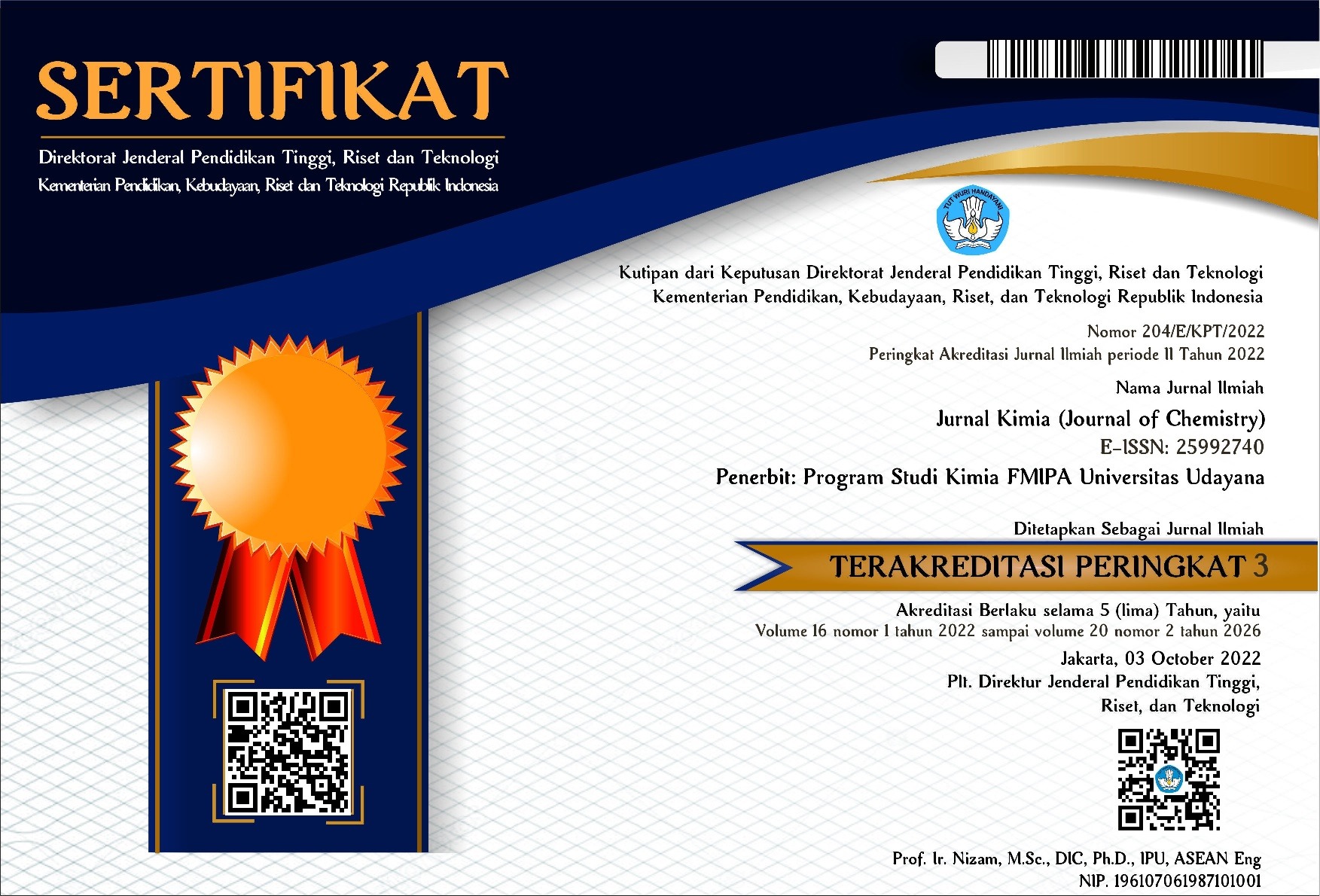KESTABILAN JANGKA PANJANG POLYMER INCLUSION MEMBRANE BERBASIS POLIVINIL KLORIDA SEBAGAI POLIMER PENDUKUNG DAN ASAM DI-2-ETILHEKSIL FOSFAT SEBAGAI EKSTRAKTAN DALAM ASAM NITRAT
Abstract
Polymer Inclusion Membrane (PIM) adalah salah satu jenis membran cair terbaru yang aplikasinya ditujukan untuk memisahkan analit tertentu secara selektif dari campurannya. Salah satu faktor kunci yang menentukan efektivitas pemisahan menggunakan PIM adalah kestabilannya dalam berbagai kondisi selama proses pemisahan berlangsung. Penelitian ini difokuskan untuk mengevaluasi stabilitas jangka panjang PIM yang terbuat dari 60% polivinil klorida (PVC) sebagai polimer pendukung dan 40% asam di-2-etilheksil fosfat (D2EHPA) sebagai agen pengekstrak dalam larutan penguji asam nitrat (HNO?) 2,5 M. PIM yang diproduksi memiliki sifat fisik yang optimal, seperti transparan, elastis, tipis, dan memiliki permukaan yang tidak berminyak. Hasil penelitian memperlihatkan bahwa setelah direndam dalam larutan HNO? 2,5 M selama tujuh hari, PIM mengalami penurunan massa sebesar 4,30%. Sementara itu, PIM yang dibiarkan dalam udara terbuka dan yang direndam dalam air selama tujuh hari mengalami penurunan massa sebesar 1,23% dan 10,15%, secara berturut-turut. Tren ini mengindikasikan bahwa PIM dengan komposisi ini lebih stabil dalam lingkungan asam dibandingkan dengan lingkungan netral. Analisis spektra FTIR PIM awal dan PIM sesudah uji stabilitas mengungkapkan bahwa PIM yang direndam dalam air selama tujuh hari mengalami kehilangan signifikan agen pengekstrak D2EHPA selama proses pengujian. Hal ini juga dikonfirmasi melalui perubahan karakteristik fisik PIM setelah uji stabilitas, termasuk sudut kontak air, daya serap air, kuat tarik, dan persentase pemanjangan. Secara umum, temuan ini menunjukkan bahwa PIM dengan yang diproduksi dengan rasio PVC 60% dan D2EHPA 40% lebih direkomendasikan untuk penggunaan dalam proses pemisahan dalam kondisi asam guna menjaga efisiensi pemisahan dan kestabilannya.
Kata kunci:
polymer inclusion membrane, PIM, stabilitas PIM, PVC, D2EHPA, 2,5 M HNO3
ABSTRACT
A Polymer Inclusion Membrane (PIM) is a novel type of liquid membrane developed for selectively separating specific analytes from their mixtures. The effectiveness of separation using PIM largely depends on its stability under various conditions during the process. This study focused on assessing the long-term stability of PIM made from 60% polyvinyl chloride (PVC) as the supporting polymer and 40% di-2-ethylhexyl phosphoric acid (D2EHPA) as the extracting agent, tested in a 2.5 M nitric acid (HNO?) solution. The fabricated PIM exhibited favourable physical properties such as being thin, transparent, flexible, and having a non-oily surface. The findings showed that PIM immersed in 2.5 M HNO? experienced a 4.30% mass reduction, while PIM exposed to open air and PIM submerged in water for seven days showed mass reductions of 1.23% and 10.15%, respectively. This trend revealed that the PIM composed of 60% PVC and 40% D2EHPA composition was more stable in an acidic environment compared to a neutral one. FTIR analysis before and after the stability test demonstrated that PIM submerged in water lost a significant amount of the D2EHPA extractant. This finding was further supported by changes in the PIM's physical characteristics, such as water contact angle, water uptake, tensile strength, and elongation percentage. Overall, the results suggested that PIM, composed of 60% PVC and 40% D2EHPA, was more suitable for separation processes in acidic conditions due to its separation efficiency and enhanced stability.
Keywords:
polymer inclusion membrane, PIM, PIM stability, PVC, D2EHPA, 2,5 M HNO3
Downloads
References
Almeida, M. I. G. S., Cattrall, R. W., Kolev, S. D., 2012. Recent trends in extraction and transport of metal ions using polymer inclusion membranes (PIMs). J. Membr. Sci. 415-416, 9-23. http://dx.doi.org/10.1016/j.memsci.2012.06.006
Almeida, M. I. G. S., Cattrall, R. W., Kolev, S. D., 2017. Polymer inclusion membranes (PIMs) in chemical analysis - A review. Anal. Chim. Acta 987, 1-14. https://doi.org/10.1016/j.aca.2017.07.032
Benosmane, N., Boutemeur, B., Hamdi, S. M., Hamdi, M., 2022. Removal of methylene blue dye from aqueous solutions using polymer inclusion membrane technology. Appl. Water Sci. 12, 104. https://doi.org/10.1007/s13201-022-01627-1
Cardoso, V. F., Machado, A. R., Pinto, V. C., Sousa, P. J., Botelho, G., Minas, G., Lanceros-Méndez, S., 2016. From superhydrophobic- to superhydrophilic-patterned poly(vinylidene fluoride-co-chlorotrifluoroethylene) architectures as a novel platform for biotechnological applications. J. Polym. Sci., Part B: Polym. Phys. 54, 1802-1810. https://doi.org/10.1002/polb.24099
Dahdah, H., Sellami, F., Dekkouche, S., Benamor, M., Senhadji-Kebiche, O., 2022. Stability study of polymer inclusion membranes (PIMs) based on acidic (D2EHPA), basic (Aliquat 336) and neutral (TOPO) carriers: effect of membrane composition and aqueous solution. Polym. Bull., 1-31. https://doi.org/10.1007/s00289-022-04362-4
Fajar, A. T. N., Goto, M., 2023. Enabling metal sustainability with polymer inclusion membranes: A critical review. J. Chem. Eng. Jpn. 56, 2153547. https://doi.org/10.1080/00219592.2022.2153547
Gherasim, C., Cristea, M., Grigoras, C., Bourceanu, G., 2011. New polymer inclusion membrane. Preparation and characterization. Dig. J. Nanomater. Bios. 6, 1499-1508.
Indarti, D., Novitasari, N., Sulistyo, Y., 2017. Pemisahan Pb (II) Menggunakan Supported Liquid Membrane (SLM) dengan Variasi Jumlah Senyawa Pembawa dan Konsentrasi Larutan Umpan. Jurnal Ilmu Dasar 18, 139-144.
Ji, S., Gao, C., Wang, H., Liu, Y., Zhang, D., Zhang, S., Lu, X., Wu, Y., Hu, Z., 2019. Application of a bio‐based polyester plasticizer modified by hydrosilicon‐hydrogenation reaction in soft PVC films. Polym. Adv. Technol. 30, 1126-1134. https://doi.org/10.1002/pat.4546
Kaczorowska, M. A., 2022. The use of polymer inclusion membranes for the removal of metal ions from aqueous solutions—The latest achievements and potential industrial applications: A review. Membranes 12, 1135. https://doi.org/10.3390/membranes12111135
Kagaya, S., Ryokan, Y., Cattrall, R. W., Kolev, S. D., 2012. Stability studies of poly(vinyl chloride)-based polymer inclusion membranes containing Aliquat 336 as a carrier. Sep. Purif. Technol. 101, 69-75. https://doi.org/10.1016/j.seppur.2012.09.007
Kebiche-Senhadji, O., Mansouri, L., Tingry, S., Seta, P., Benamor, M., 2008. Facilitated Cd(II) transport across CTA polymer inclusion membrane using anion (Aliquat 336) and cation (D2EHPA) metal carriers. J. Membr. Sci. 310, 438-445. https://doi.org/10.1016/j.memsci.2007.11.015
Khalid, N. A., Shoparwe, N. F., Yusoff, A. H., Sulaiman, A. Z., Ahmad, A. L., Azmi, N. A., 2022. Fabrication and Characterisation of MWCNT/Polyvinyl (PVC) Polymer Inclusion Membrane for Zinc (II) Ion Removal from Aqueous Solution. Membranes 12, 1020. https://doi.org/10.3390/membranes12101020
Kiswandono, A. A., Rinawati, R., Agustina, W., Hadi, N., Nurhasanah, N., Rahmawati, A., Nitti, F., Lusiana, R. A., 2024. Transport of phenol using supported liquid membrane containing Eugenol cross-linked by diallyl phthalate or divinyl benzene as a carrier. J. Membr. Sci. Res. 10, -. https://doi.org/10.22079/jmsr.2024.2009799.1626
Kolev, S. D., Baba, Y., Cattrall, R. W., Tasaki, T., Pereira, N., Perera, J. M., Stevens, G. W., 2009. Solid phase extraction of Zinc(II) using a PVC-based polymer inclusion membrane with di(2-ethylhexyl)phosphoric acid (D2EHPA) as the carrier. Talanta 78, 795-9. https://doi.org/10.1016/j.talanta.2008.12.047
Kunene, P., Akinbami, O., Motsoane, N., Tutu, H., Chimuka, L., Richards, H., 2020. Feasibility of polysulfone as base polymer in a polymer inclusion membrane: synthesis and characterisation. J. Membr. Sci. Res. 6, 203-210. https://dx.doi.org/10.22079/jmsr.2019.111596.1278
Kuswandi, B., Nitti, F., Almeida, M. I. G. S., Kolev, S. D., 2020. Water monitoring using polymer inclusion membranes: A review. Environ. Chem. Lett. 18, 129-150. https://doi.org/10.1007/s10311-019-00930-9
Lailyningtyas, D. I., Ahmad, A. M., 2020. Uji mekanik bioplastik berbahan pati umbi ganyong (Canna edulis) dengan variasi selulosa asetat dan sorbitol. Jurnal Keteknikan Pertanian Tropis dan Biosistem 8, 91-100. doihttps://doi.org/10.21776/ub.jkptb.2020.008.01.09
Ling, Y. Y., Mohd Suah, F. B., 2017. Extraction of malachite green from wastewater by using polymer inclusion membrane. J. Environ. Chem. Eng. 5, 785-794. https://doi.org/10.1016/j.jece.2017.01.001
Maiphetlho, K., Shumbula, N., Motsoane, N., Chimuka, L., Richards, H., 2020. Evaluation of silver nanocomposite polymer inclusion membranes (PIMs) for trace metal transports: Selectivity and stability studies. J. Water Process Eng. 37, 101527. https://doi.org/10.1016/j.jwpe.2020.101527
Modhe, K., Ledoh, S. M., Lapailaka, T., Kadang, L., Naat, J. N., Pingak, R. K., Kapitan, O. B., Nitti, F., 2024. Stabilitas polymer inclusion membrane dari polimer pendukung PVC dan ekstraktan D2EHPA dalam asam klorida. Jurnal Fisika: Fisika Sains dan Aplikasinya 9, 36-46. https://doi.org/10.35508/fisa.v9i1.15377
Ncib, S., Chibani, A., Barhoumi, A., Larchet, C., Dammak, L., Elaloui, E., Bouguerra, W., 2023. Separation of copper and nickel from synthetic wastewater by polymer inclusion membrane containing di (2-ethylhexyl) phosphoric acid. Polym. Bull. 80, 12177-12192. https://doi.org/10.1007/s00289-022-04634-z
Nghiem, L. D., Mornane, P., Potter, I. D., Perera, J., Cattrall, R. W., Kolev, S. D., 2006. Extraction and transport of metal ions and small organic compounds using polymer inclusion membranes (PIMs). J. Membr. Sci. 281, 7-41. https://doi.org/10.1016/j.memsci.2006.03.035
Nitti, F. Development of flow-through devices for passive sampling of zinc (II) in aquatic systems free from environmental effects. Ph.D. University of Melbourne, 2020.
Nitti, F., Almeida, M. I. G. S., Morrison, R., Cattrall, R. W., Pettigrove, V. J., Coleman, R. A., Kolev, S. D., 2018. Development of a portable 3D-printed flow-through passive sampling device free of flow pattern effects. Microchem. J. 143, 359-366. https://doi.org/10.1016/j.microc.2018.08.029
Nitti, F., Almeida, M. I. G. S., Morrison, R., Cattrall, R. W., Pettigrove, V. J., Coleman, R. A., Kolev, S. D., 2022a. Flow-through passive sampler for zinc in freshwaters free from flow pattern, water cationic composition and temperature effects. Microchem. J. 177, 107294. https://doi.org/10.1016/j.microc.2022.107294
Nitti, F., Selan, O. T. E., Hoque, B., Tambaru, D., Djunaidi, M. C., 2022b. Improving the performance of polymer inclusion membranes in separation process using alternative base polymers: A review. Indones. J. Chem. 22, 284 - 302. https://doi.org/10.22146/ijc.68311
Oluwasola, E. I., Ahmad, A. L., Shoparwe, N. F., 2023. Evaluation of polymer inclusion membranes based on PVC containing HDEHP as a carrier for aqueous tetracycline transportation. J. Water Process Eng. 52, 103508. https://doi.org/10.1016/j.jwpe.2023.103508
Oluwasola, I. E., Ahmad, A. L., Shoparwe, N. F., 2022. Preliminary Study on the Stability of Self Plasticised Thin-Flat PIM for the Extraction of 2-(4-Isobutylphenyl) Propanoic Acid (Ibuprofen). J. Membr. Sci. Res. 8. https://doi.org/10.22079/jmsr.2022.553756.1546
Rensini, W. A., Kadang, L., Lapailaka, T., Naat, J. N., Pingak, R. K., Kapitan, O. B., Nitti, F., 2024. Uji stabilitas polymer inclusion membrane dari polimer pendukung PVC, ekstraktan D2EHPA, dan plasticizer asam oleat pada kondisi asam. Jurnal Beta Kimia 4, 1-18. https://doi.org/10.35508/jbk.v4i1.15351
Rumhayati, B., Wiryawan, A., Dinira, L., Afifah, S., 2021. Fabrication and characterization of passive sampler using polymeric inclusion membrane (PIM) as diffusion layer for phosphate measurement. JKPK (Jurnal Kimia dan Pendidikan Kimia) 6, 29-38. https://doi.org/10.20961/jkpk.v6i1.49825
Rzelewska-Piekut, M., Regel-Rosocka, M., 2023. Liquid membranes for separation of metal ions from wastewaters. Physical Sciences Reviews 8, 937-982. https://doi.org/10.1515/psr-2021-0049
Sellami, F., Kebiche-Senhadji, O., Marais, S., Fatyeyeva, K., 2022. PVC/EVA-based polymer inclusion membranes with improved stability and Cr(VI) extraction capacity: Water plasticization effect. J. Hazard. Mater. 436, 129069. https://doi.org/10.1016/j.jhazmat.2022.129069
Wang, D., Hu, J., Liu, D., Chen, Q., Li, J., 2017. Selective transport and simultaneous separation of Cu(II), Zn(II) and Mg(II) using a dual polymer inclusion membrane system. J. Membr. Sci. 524, 205-213. https://doi.org/10.1016/j.memsci.2016.11.027
Zhang, L. L., Cattrall, R. W., Ashokkumar, M., Kolev, S. D., 2012. On-line extractive separation in flow injection analysis based on polymer inclusion membranes: a study on membrane stability and approaches for improving membrane permeability. Talanta 97, 382-7. https://doi.org/10.1016/j.talanta.2012.04.049

This work is licensed under a Creative Commons Attribution 4.0 International License





